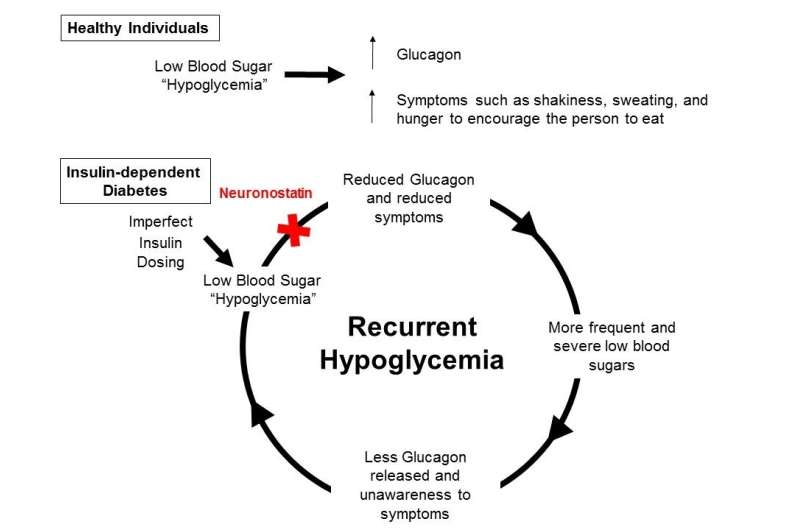New hope for preventing dangerous diabetes complication

People with diabetes who use insulin to control their blood sugar can experience a dangerous condition called hypoglycemia when blood sugar levels fall too low. New insights into a recently discovered protein called neuronostatin could lead to new ways to treat and prevent hypoglycemia, which is sometimes deadly for people with diabetes.
Stephen Grote, a doctoral student working with Gina Yosten, Ph.D., at Saint Louis University School of Medicine, will present the research at the American Physiological Society's annual meeting during the 2019 Experimental Biology meeting to be held April 6-9 in Orlando, Fla.
For people with diabetes, taking too much insulin can lead to low blood sugar, causing dizziness and sleepiness. Symptoms may progress to confusion, seizures and loss of consciousness if blood sugar levels continue to fall. Severe hypoglycemia can also increase the risk of more hypoglycemic episodes in the following days and leads to a decreased awareness of the symptoms that typically allow a person to sense falling blood sugar levels.
"There are very few options for preventing hypoglycemia or treating hypoglycemia unawareness other than avoiding low blood sugar as much as possible," Grote said. "Understanding what neuronostatin does and how it works will provide valuable information for preventing hypoglycemia and provide more complete knowledge into how the pancreas manages blood sugar normally."
In previous work, Yosten's research group discovered neuronostatin. Their work has shown that the protein protects against hypoglycemia by causing the pancreas to release less insulin and make more glucagon, a hormone that helps regulate blood sugar levels.
In a new rat study, the researchers observed that neuronostatin injections caused an increase in blood sugar. They also examined human pancreas tissue and found that it released more neuronostatin when blood sugar levels were low and that neuronostatin increased even more with glucagon treatment. The new research points to neuronostatin as a potential therapeutic target for the treatment and prevention of hypoglycemia in people with diabetes.
"Neuronostatin is a truly novel factor, and everything we find about it pushes our knowledge of its therapeutic potential just a bit further," said Grote. "We believe that studying neuronostatin could ultimately reveal a way to use it to help prevent and reverse vicious cycles of hypoglycemia by helping the body respond appropriately to the low blood sugar with more glucagon."
The researchers are now working to better understand how neuronostatin affects glucagon and insulin release from human islets and how the body regulates neuronostatin secretion. They are also using experimental approaches that disrupt the body's response to low blood sugar to investigate how this affects neuronostatin levels and to determine if neuronostatin can be used to better manage low blood sugar.
More information: Stephen Grote will present this research during the Experimental Biology Welcome Reception on Saturday, April 6 at 7 p.m. in the Valencia Ballroom ABCD, Orange County Convention Center and on Monday, April 8, from 10:15 a.m.-12:15 p.m. in Exhibit Hall-West Hall B (poster E621 756.1) (abstract).


















